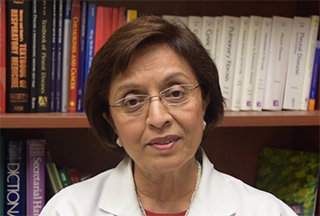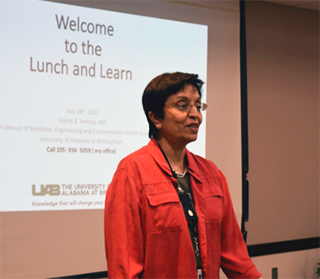March 4, 2022
As director of the University of Alabama at Birmingham’s SRP Center, Veena Antony, M.D., is committed to improving lung health in residents near a local Superfund site.

Veena Antony, M.D., a pulmonologist in the Department of Medicine at the University of Alabama at Birmingham (UAB), traces her fixation with lung health to growing up with asthma.
As she dove into pulmonary research, first as a medical student in India and later as a fellow in pulmonary critical care at the University of Colorado, Antony was intrigued by how surrounding air, soil, and water can affect the respiratory system.
“I began to realize that lung disease is not always driven by genetics alone. The environment can play a large role, whether it’s contributing to the disease or worsening symptoms,” she said.
After working at several university medical centers, including the University of Florida, where she was chief of pulmonary medicine and critical care, Antony joined UAB as a clinical professor in 2010.
The school is located near the 35th Avenue Superfund site, where the U.S Environmental Protection Agency is cleaning up contaminants such as cadmium, arsenic, and lead.
Industrial facilities, including two coke oven plants, steel manufacturers, and quarries, among other operations, exist within the site and surrounding areas. About 20,000 people, mostly African Americans, also live within the 35th Avenue footprint.
Over the years, Antony has treated many patients from those neighborhoods who suffer from chronic obstructive pulmonary disease (COPD), which manifests as shortness of breath, cough, and mucus production.
“I began to wonder, what is going on?” she recalled. “Because cases of COPD were more common than expected, I thought that environmental contaminants must play a role. So, I brought colleagues together from different departments to see how we could help the community.”
In 2020, the UAB SRP Center debuted, with Antony as director.
“Our overarching goal is to understand connections between contaminant exposures and lung health so we can help people better manage diseases like COPD, asthma, and lower respiratory tract infections,” Antony explained. “Importantly, we are also exploring new ways to locate and remove sources of contamination so the community will be better protected from future exposures.”
Homing In on Heavy Metals
Through the UAB SRP Center and an NIEHS-funded individual research grant, Antony examines how exposure to heavy metals such as cadmium affect the development of COPD and pulmonary fibrosis, a disease that causes shortness of breath, dry cough, and fatigue, among other symptoms.
“COPD results from inflammation along the bronchial tubes — the airways that stem from each lung to connect at your windpipe,” Antony explained. “On the other hand, pulmonary fibrosis results from scarring in the lung’s air sacs, called alveoli. Alveolar scarring prevents oxygen from getting into the blood.”
In the United States, pulmonary fibrosis is less common than COPD. Yet, a disproportionate number of 35th Avenue residents develop the disease, according to Antony. Based on their research so far, Antony and colleagues think that exposure to air containing cadmium and other heavy metals is the main cause of pulmonary fibrosis in the community.
In 2021, her team showed that cadmium exposure kickstarts a chain of molecular events involving a structural protein called vimentin, which changes into a form that promotes alveolar scarring. They also found that higher levels of modified vimentin corresponded with worse scarring.
According to Antony, cadmium appears to promote the development of COPD as well; published research is forthcoming.
“Now, why do some people get COPD and some people get pulmonary fibrosis? We think that depends on their genetic makeup,” Antony said.
Continuing Conversations

Antony maintains a running dialogue with 35th Avenue residents about SRP research. For instance, her team regularly updates their community advisory board, and Antony shares information at community centers and churches.
“The relationship is bidirectional. They tell us what is bothering them the most, and we look into it,” Antony said.
The center also collaborates with the community on outreach and education projects. One activity involves teaching people how to grow food in raised garden beds containing uncontaminated soil.
Meanwhile, through a Lung Ambassadors program, high school students learn about health problems associated with the Superfund site and ways to minimize contaminant exposures. Then they pass those lessons on to family and friends.
Future Directions
Looking ahead, Antony hopes to explore ways to alleviate respiratory illness in the 35th Avenue community. One approach involves blocking contaminants from activating disease pathways in the first place.
For example, in 2007, the Columbia SRP Center published a study conducted in Bangladesh showing that folic acid supplements can dramatically lower blood arsenic levels in people chronically exposed to arsenic-contaminated drinking water.
Antony envisions running a similar clinical trial with participants from the Superfund site, where arsenic exposure is a major concern. Many children at the local primary school suffer from asthma, which could be linked to inhaling arsenic in dust, according to Antony.
“Folate is a vitamin that will change arsenic into a water-soluble form that can be excreted in the urine,” she explained. “We want to see if administering folic acid supplements leads to a decline in arsenic levels in the blood.”
In 2019, UAB presented Antony with the Dean’s Excellence Award in Service to honor her dedication to Birmingham and the 35th Avenue community.
“These are people who fought for their civil rights, and now they are asking for environmental equity,” Antony said. “We have a partnership with the school of public health, the school of engineering, environmental scientists, and the community. We’re committed to helping our neighbors.”


